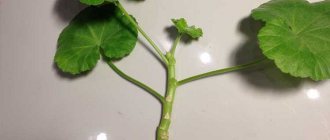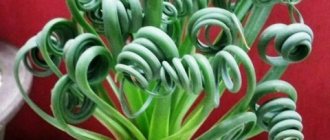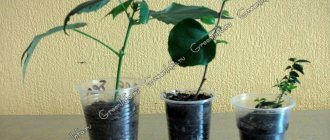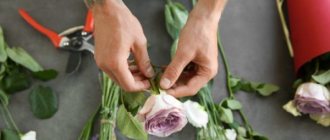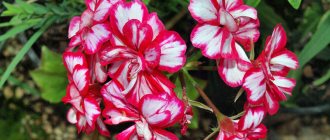Vegetative propagation is carried out due to the division of cells of the vegetative organs of plants.
The following methods of vegetative propagation of plants are known: 1) using modified shoots (tubers, bulbs, rhizomes, stolons); 2) parts of vegetative organs (stems, leaves, roots); 3) grafting (kidneys).
Reproduction by modified shoots
Plant propagation by rhizomes is widely used in landscaping areas, squares, and schoolyards. The rhizomes of plants such as iris and lily of the valley are divided into parts so that 2-3 buds remain on each segment and planted in the soil. A plant develops from each part of the rhizome. Next year it may already bloom. Initially, rhizomatous plants produce 1-2 shoots, then their number increases annually (Fig. 1).
Fig.1 Rhizome of lily of the valley
Potatoes are most often propagated by tubers. If the tuber is large, it is divided in half or into several parts, leaving 1-2 eyes on each of them (Fig. 2).
Fig.2 Propagation by tubers
Onions, garlic, lilies, tulips, hyacinths and many other plants reproduce from bulbs. This method of propagation makes it possible to cause flowering even in winter (Fig. 3).
Fig.3 Tulip propagation by bulbs
Strawberries are most often propagated by stolons. At the point where the long whiskers touch the ground, adventitious roots appear. Then a shortened shoot develops. Having separated the young rosettes from the whiskers, they are seated (Fig. 4).
Fig.4 Propagation of strawberries by stolons
Flower cuttings
Cuttings are a method of propagating indoor flowers by separating and rooting parts of the mother plant: shoots, stem fragments, leaves. It is the most popular and productive method of propagation. Many herbaceous species, subshrubs and shrubs, as well as succulents, are propagated by cuttings.
Cuttings are suitable for propagation of the following species:
- Tradescantia;
- Balsam;
- Coleus;
- Hibiscus;
- Ivy;
- Ficus;
- Korldilina;
- Dracaenas;
- Dieffenbachia;
- Sansevieria;
- Begonia;
- Saintpaulia;
- Gloxinia;
- Peperomia;
- Cacti;
- Many types of Crassula;
- Spurge.
Propagation by apical cuttings
Apical cuttings are cut from the shoots of the plant.
They are usually harvested during scheduled spring pruning. The tops of the shoots are cut off, stimulating branching. Cuttings are cut from such removed parts. They must be strong and thick enough; it is not recommended to take cuttings from weak and elongated shoots. The length of the cuttings depends on the type of plant. But each of them must have several pairs of leaves or nodes.
The lower cut is made obliquely and close to the lower bud. It is recommended to treat cuttings of poorly rooted species with root growth stimulants. Root cuttings in soil or water. For many species, when rooting in the soil, it is necessary to create increased humidity. To do this, the cuttings are covered with glass jars or film. When rooting in water, they are placed in boiled water at room temperature. It is recommended to change the water at least once every 2 days.
Propagation by stem cuttings
For cuttings, you can also use stem fragments that do not have an upper growing point. These are stem cuttings. Very often, cordilines and dracaenas, whose trunk is very exposed, are propagated in this way. Their top is cut off and rooted, and the remaining trunk is cut into cuttings.
Stem cuttings are prepared in the same way as apical ones. If they are of considerable thickness, then it is recommended to cover the upper cut with garden varnish so that the cutting does not lose moisture through it.
The methods for rooting them are the same as for apical cuttings. They take longer to take root, but you can quickly grow a lush plant from a stem cutting. In the absence of an upper growth point, the cutting immediately begins to form side shoots after rooting.
Reproduction by parts of vegetative organs
Young shoots can be obtained from the stem, leaf, or root. The part of the stem with buds used for propagation is called a cutting. For propagation of willow, poplar, maple, grapes and other plants, winter (without leaves) and summer (with leaves) shoots are used (Fig. 5).
Fig.5 Propagation by cuttings
In home gardening, propagation by layering is widely used. To do this, a branch, for example a currant, is bent to the ground, secured and sprinkled, leaving the top above the soil. The rooted cuttings are separated from the mother plant and planted in a designated area (Fig. 6)
Fig.6 Reproduction by layering
Perennial decorative flowers (carnations, pelargonium, coleus, tradescantia, ficus, etc.) are propagated from green stem shoots. To do this, a young shoot 10-15 cm long is separated from a houseplant, planted in a flower pot with previously prepared soil (the bottom of the pot is filled with 1-2 cm of sand) and watered (Fig. 7).
Fig.7 Reproduction by stem shoots
Begonia and violets can be propagated by leaves or even parts of them. And in bryophyllum, small rosette shoots, already with roots, develop right on the edge of the leaf blade of the mother plant (Fig. 8).
Fig.8 Reproduction by leaves
Daisies, gooseberries, raspberries, currants, etc. are propagated by dividing the bush. Rose hips are often planted as a green hedge, which is propagated by dividing the root and root cuttings. The formation of adventitious buds on the roots gives rise to root shoots. Adventitious roots grow from these shoots. Over time, they separate and become independent. Even small pieces of root (1-4 cm), which have accessory buds, give rise to new above-ground shoots.
Artificial ways
Cuttings are parts of a shoot, root, or leaf cut for this purpose. Stem cuttings are one- and two-year-old shoots 20-30 cm long. Cut cuttings are planted in the soil. At their lower end, adventitious roots grow, and new shoots grow from the axillary buds. To increase survival rate, before planting, the lower ends of the cuttings are treated with solutions of growth stimulants. Many varieties of currants, gooseberries, grapes, roses, etc. are propagated by cuttings.
Begonias, Uzambara violets, lemon, etc. are propagated by leaf cuttings
Root cuttings - sections of lateral roots 10-20 cm long are harvested in the fall, stored in sand and planted in greenhouses in the spring. Used for propagation of cherries, plums, raspberries, chicory, apple trees, roses, etc.
Vegetative propagation by cuttings
Propagation by grafting is widely used in gardening . Grafting is the merging of a bud or cutting of one plant with the stem of another growing in the soil. The cutting, or bud, is called the scion, and the plant with the root is called the rootstock.
Budding is the grafting of a bud with a piece of wood. In this case, an L-shaped cut 2-3 cm long is made on the stem of a one- or two-year-old seedling, and a horizontal cut - no more than 1 cm. Then the edges of the bark are carefully folded back, and a peephole cut with a piece of wood is inserted under the bark. The peephole is pressed tightly against the wood with bark flaps. The grafting site is tied with a washcloth, leaving the bud open. After fusion, the stem of the rootstock above the eye is removed. Budding is carried out in summer and spring.
Copulation is the grafting of a one-year-old cutting with several buds. In this case, the scion and rootstock should be the same thickness. They make identical oblique cuts. The scion is applied to the rootstock so that their tissues coincide (the matching of the cambium is especially important) and carefully tied with a washcloth. If the thickness of the rootstock and scion is different, grafting is done into the split, behind the bark, into the butt, etc.
Reproduction by grafting
Grafting is the grafting of a part of one plant (scion) onto a rooted seedling of another plant (rootstock). This method of vegetative propagation is most often used by gardeners to create new plants that are resistant to cold and pests with the desired taste qualities. For example, to create cold-resistant varieties of fruit trees, a cutting of a cultivated plant is grafted onto a wild shoot (a shoot grown from a seed). The cold resistance of the rootstock (wildstock) is transferred to the shoots developed from the grafted part of the cultivated plant. There are more than 150 methods of vaccination. Of these, the most commonly used are cutting grafting and eye (bud) grafting.
Grafting with cuttings (copulation) is carried out by transplanting a cutting with buds from one plant onto an oblique cut of a rootstock branch of the same thickness. The tightly connected parts should grow together (Fig. 9).
Fig.9 Copying
To graft with an eye (budding), a bud is cut from a cultivated plant, capturing a small part of the stem (bark and wood). A T-shaped cut is made on the rootstock bark. Then, with the blunt end of a budding knife, turn off the corners of the bark and insert a piece of scion bark with a bud the same length as the cut. After this, the graft is tied with a narrow strip of special film, leaving the bud open (Fig. 10).
Fig. 10 Budding
In specially equipped laboratories, new plants are grown from cells of educational tissue. Vegetative propagation is propagation by vegetative organs (root, stem, leaf) by their parts or modifications (rhizome, tuber, bulb, stolons).
Lily of the valley and iris reproduce by rhizome; tubers - potatoes; bulbs - onion, garlic, lily; mustache-stolons - strawberries, wild strawberries. Willow, poplar, and grapes are propagated using parts of the stem—cuttings; Violet and begonia are propagated using leaves, and raspberries and rosehips are propagated by parts of the root with adventitious buds. Grafting is a method of grafting a part of one plant with a bud onto another plant. Stem
Shoot and bud
External and internal structure of the leaf
Group 3. Tuberous plants
It includes crops that are propagated by tubers and corms. Most often propagated without leaves - during the dormant period or at the beginning of growth.
- Dahlias (Dahlia) of hybrid origin, numerous varieties, united under the name D. x cultorum, are propagated by dividing root tubers and cuttings (less often).
- Gladioli (Gladiolus) are propagated by children; very valuable varieties are propagated by dividing the corms in the spring, when sprouts are visible on them.
- Children are separated from the overgrown crocosmia, or montbretia (Crocosmia, syn. Montbretia); They are planted a little earlier and dug up later than corms. In summer, growing crocosmia are cared for more carefully.
Blooming crocosmia
- Crocuses (Crocus) are most often propagated by daughter replacement corms, Xiphiums - by baby bulbs; corydalis (Corydalis) - tubers that are dug up after the seeds ripen.
- Colchicum, or magnificent colchicum (Colchicum speciosum), is propagated by dividing a nest of corms during digging and replanting.
In our catalog, which combines offers from major online gardening stores, you will find a wide range of different tuberous, corm and bulbous flowers. Choose planting material for your dacha. Canna VERDI, 2 pcs. NEW 499 RUR
seedspost.ru
Gloxinia Jubilation F1, 5 pcs. Lavender dreams 69 rub.
seedspost.ru
Gloxinia Impress Red ink, 5 pcs. 69 RUR
seedspost.ru
Calla PICASSO, 1 pc. 210 rub.
seedspost.ru
Test on the topic: “Vegetative propagation of plants”
Time limit: 0
Navigation (job numbers only)
0 out of 15 tasks completed
Questions:
- 1
- 2
- 3
- 4
- 5
- 6
- 7
- 8
- 9
- 10
- 11
- 12
- 13
- 14
- 15
Information
The verification test task includes questions with one or more correct answers.
You have already taken the test before. You can't start it again.
The test is loading...
You must log in or register in order to begin the test.
You must complete the following tests to start this one:
results
Correct answers: 0 out of 15
Your time:
Time is over
You scored 0 out of 0 points (0)
| Average result |
| Your result |
Categories
- Botany 0%
maximum of 20 points
| Place | Name | Recorded | Points | Result |
| Table is loading | ||||
| No data | ||||
Your result has been recorded in the leaderboard Loading
- 1
- 2
- 3
- 4
- 5
- 6
- 7
- 8
- 9
- 10
- 11
- 12
- 13
- 14
- 15
- With answer
- With a viewing mark
- Task 1 of 15
1.
Vegetative reproduction occurs through cell division
Right
Wrong
- Task 2 of 15
2.
Tubers are most often propagated
Right
Wrong
- Task 3 of 15
3.
Carnations, pelargonium, coleus, tradescantia, ficus are propagated
Right
Wrong
- Task 4 of 15
4.
Most often they are used by gardeners to create new plants that are resistant to cold and pests with the desired taste qualities.
Right
Wrong
- Task 5 of 15
5.
For budding, they cut from a cultivated plant
Right
Wrong
- Task 6 of 15
6.
Winter and summer shoots are used for propagation
Right
Wrong
- Task 7 of 15
7.
Reproduces by stolons
Right
Wrong
- Task 8 of 15
8.
Begonia and violet can be propagated
Right
Wrong
- Task 9 of 15
9.
Propagated by dividing the bush
Right
Wrong
- Task 10 of 15
10.
Part of the stem with buds used for propagation
Right
Wrong
- Task 11 of 15
11.
As a result of vegetative propagation, young shoots can be obtained from
Right
Wrong
- Task 12 of 15
12.
A method of vegetative propagation that allows flowering to occur even in winter
Right
Wrong
- Task 13 of 15
13.
Propagated by rhizomes
Right
Wrong
- Task 14 of 15
14.
Propagated by bulbs
Right
Wrong
- Task 15 of 15
Group 1. Rhizomatous plants
It included rhizomatous plants propagated by cuttings and parts of vegetative organs.
- Astilbe (Astilbe) and the similar Volzhanka (Aruncus) are propagated by dividing the bush into parts, each of which should have renewal buds formed at the base of the current year's shoots. They are cut off with a small piece of rhizome and grown on light soil in shade with constant soil moisture. Volzhanka has very large lignified rhizomes - if you cannot cut it off with a knife or pruning shears, you can use a hatchet.
- Overgrown periwinkles (Vinca) are propagated by dividing rooted shoots and cuttings.
The small periwinkle itself “prepares” its planting material. Photo by the author
- We propagate varietal irises (Iris) in divisions with 1-2 buds, not only in early spring, but also after flowering. The process is described in more detail in the publications Dividing dwarf irises and Take two - dividing bearded irises.
- Large-flowered varieties of clematis (Clematis), in addition to dividing and rooting by layering, take cuttings. You can divide the vine when your clematis is 5-6 years old. Layers are rooted in summer or autumn, and separated in the 2-3rd year.
- Divisions of lilies of the valley (Convallaria) are planted at the end of summer, as they do not take root well in the spring.
- Varieties of hybrid daylily (Hemerocallis x hybrida) are divided in early spring or autumn.
The decorative characteristics of the 'Dalves Dance' variety can only be preserved vegetatively. Photo by the author
- Varietal peonies (Paeonia) are propagated by dividing bushes, renewal buds, stem and root cuttings. Delenka - 1-2 root tubers with roots and 3-5 well-developed buds. If, during division, stems with buds and individual root tubers with small buds come off from the bushes, then do not throw them away, these are also future peonies. Stem and root cuttings are planted in a well-prepared bed in the shade and grown for 2-3 years, after which they are transplanted to a permanent place in the flower garden.
We also divide peonies, preserving the beauty of the varieties. Photo by the author
- Wormwood (Artemisia), sedum (Sedum) are not only divided, but also cut.
- Varieties of garden canna, or hybrid (Canna x hybrida), are propagated in divisions with 1-2 buds.
- To obtain a large amount of chrysanthemum planting material (Chrysanthemum), cuttings are taken from the mother plant (the process is described in detail in the publication Cuttings of Chrysanthemums). Less often, they divide and produce root shoots.
The small-flowered chrysanthemum variety 'Nikolina', created at NBS in 2006, has been preserved, cuttings and shown at annual exhibitions for 14 years.
Photo by the author You will probably find all the plants described in this section in our catalog, which contains offers from many large garden online stores. Choose the most beautiful varieties for your garden. Delphinium Crystal fountain, 15 pcs 63 RUR
seedspost.ru
Alpine aster Blue, 0.1 g Alpine slide 32 RUR
seedspost.ru
Amberboa nutmeg Sultan Lilac, 40 pcs. 44 rub.
seedspost.ru
Heuchera Lights of Moscow, Mix, 0.01 g 26 rub.
seedspost.ru
Bacopa
Bacopa varieties grown from seeds play a secondary role, shading the brighter plants in flower arrangements, because they have very small, pale flowers. But vegetative bacopa is so good that it can be planted as a soloist.
And this is not surprising, because the flowers of the bacopa variety ' Double Snowball White' are three times larger than those of most varieties and, moreover, even double. So you don’t immediately recognize bacopa in this beautiful bride. In addition, it became possible to grow mauve bacopa from seeds only last year, and previously the crimson-flowered bacopa was only available in vegetative form. Also interesting is the hybrid ' Gulliver Violet Glow' with raspberry-violet flowers.
Bacopa, variety 'Double Snowball White'. © Danziger
Where to buy vegetative cuttings?
The easiest way to purchase vegetative hybrids is at the market where plants are usually sold. Typically, entrepreneurs purchase such cuttings in bulk from Holland in advance, after which they grow them themselves and, by the time of planting, present buyers with well-formed bushes, densely covered with flowers.
But sometimes nurserymen save queen cells in the winter and carry out cuttings themselves in the spring. Also, “vegetative” is very actively sold in various online stores. In the latter case, although it is easier to select the most interesting varieties, you can easily be disappointed due to the fact that they may send very tiny, barely rooted cuttings rather than fully grown ones.
In any case, when buying “vegetative” in an online store, you need to give preference to those that are not too distant from you, otherwise the cuttings may simply not arrive or arrive very weakened.
How does a fern reproduce?
The graceful and elegant greenery of ferns is a magnificent decoration for offices, hallways and shady rooms. Ferns are also recognized as one of the main components for creating a variety of flower arrangements. To propagate ferns, you can use two methods. The first, of course, involves the most primitive method - dividing the rhizome.
But, we can also reproduce ferns using spores that are located on the underside of the leaves. After the spore leaf has matured, it should be placed in a simple plastic bag. The spores will fall off, then you can easily collect them and sow them in a heated and disinfected substrate. Select containers for planting that are not deep.
The bowls must be carefully covered with a plastic bag and placed in a bright and warm place. Watering should be done regularly. Over time, in about two and a half to three months, small shoots will appear. When the sprouts reach a height of five to six centimeters, the plants dive.
Osteospermum
Osteospermum is an interesting plant from the Asteraceae family, and another exotic variation of multi-colored “daisies”. Depending on the variety, this flower can also look like asters or chrysanthemums. Moreover, the height of the plant is only 30 centimeters (seed varieties are usually 40-50 centimeters tall), so it is an excellent potted plant.
There are varieties of osteospermum that are grown from seeds, but vegetative osteospermum has some truly fantastic variations. For example, the hybrid ' Flower Power Purple Sun' is a new product from last year that received a prestigious award. And, indeed, it is hardly possible to find another flower whose petals combine such exotic colors.
Another very worthy variety, ' Margarita Double Pink', is distinguished by the presence of "pompoms" in the center of the flower, which makes it similar to varietal echinacea. By their nature, osteospermum is a perennial and queen cells can be preserved in winter as a houseplant. However, osteospermum cuttings take root very difficult, so it is better to purchase young plants anew in the form of rooted cuttings.
Osteospermum, variety 'Margarita Double Pink'. © onava
